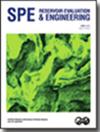In-Situ Steam Generation Using Mist Water-Air Injection as Enhanced Oil Recovery and Energy Efficiency Process: Kinetic Modeling and Numerical Simulation Approach
IF 1.5
4区 工程技术
Q3 ENERGY & FUELS
引用次数: 1
Abstract
In the current energy transition era, oil exploitation and especially the development of heavy oil reservoirs are facing big challenges to overcome the possible limitations in terms of economy (oil price), energy efficiency, and carbon footprint. Particularly, thermal enhanced oil recovery processes need to be re-evaluated in an attempt to harness the injected and produced energy. In that sense, Ecopetrol is evaluating new strategies to optimize the current steam injection process using different hybrid technologies from laboratory to field scale. One of the most attractive initiatives is evaluating the in-situ steam generation using mist water-air injection. This process involves simultaneous air and water injection into the formation through a set of nozzles. It looks to use part of the in-situ oil as a fuel, using the reservoir not only as a tank of energy but also as a steam generator. The main contribution of the technique concerning conventional steam generation is the use of the heat from the combustion of the residual oil to generate an in-situ steam front to transfer the uncontacted oil. This is reflected in reduced carbon dioxide (CO2) emissions, reduced fuel and water requirements, and increased oil production and net energy recovery. This article describes the methodology, results, history matching, and kinetic modeling of experimental evaluations and the upscaling of the experimental observations to a representative sector model from a Colombian heavy oil field. Results are described in terms of incremental oil recovery, energy efficiency, and carbon intensity compared with the baseline (a traditional steamflooding scenario). The technology of in-situ steam generation using mist waterair injection led to benefits in terms of better energy use and reducing the external fuel dependency for steam generation at the surface. Additionally, it was possible to identify improvements in incremental oil recovery (around 90%), energy efficiency (about 10 times less energy required to produce 1 m3 of oil), and reduction in carbon intensity (up to 91%) considering as baseline a conventional steamflooding scenario. These results will be key input parameters for designing and commissioning future applications in the Colombian fields.利用雾状水-空气原位蒸汽生成提高采收率和能源效率的过程:动力学建模和数值模拟方法
在当前能源转型时代,石油开采特别是稠油油藏的开发面临着巨大的挑战,需要克服经济(油价)、能源效率和碳足迹方面可能存在的限制。特别是,为了利用注入和产出的能量,需要重新评估热增强采油过程。从这个意义上说,Ecopetrol正在评估新的策略,以优化目前从实验室到现场规模的不同混合技术的蒸汽注入工艺。最具吸引力的举措之一是评估使用雾水-空气注入的原位蒸汽产生。该过程包括通过一组喷嘴同时向地层注入空气和水。它希望使用部分原位石油作为燃料,将储层不仅用作能量罐,还用作蒸汽发生器。该技术对传统蒸汽产生的主要贡献是利用残余油燃烧产生的热量来产生原位蒸汽锋,以转移未接触的油。这反映在减少二氧化碳(CO2)排放、减少燃料和水的需求、提高石油产量和净能源回收率上。本文描述了实验评估的方法、结果、历史匹配和动力学建模,并将实验观察结果升级为哥伦比亚稠油油田的代表性部门模型。与基线(传统的蒸汽驱方案)相比,结果描述了增量采收率、能源效率和碳强度。使用雾状水-空气喷射的原位蒸汽产生技术在更好地利用能源和减少对地面蒸汽产生的外部燃料依赖方面带来了好处。此外,考虑到常规蒸汽驱方案的基线,可以确定在增量采收率(约90%)、能源效率(生产1立方米石油所需能源减少约10倍)和碳强度降低(高达91%)方面的改进。这些结果将成为设计和调试哥伦比亚油田未来应用的关键输入参数。
本文章由计算机程序翻译,如有差异,请以英文原文为准。
求助全文
约1分钟内获得全文
求助全文
来源期刊
CiteScore
5.30
自引率
0.00%
发文量
68
审稿时长
12 months
期刊介绍:
Covers the application of a wide range of topics, including reservoir characterization, geology and geophysics, core analysis, well logging, well testing, reservoir management, enhanced oil recovery, fluid mechanics, performance prediction, reservoir simulation, digital energy, uncertainty/risk assessment, information management, resource and reserve evaluation, portfolio/asset management, project valuation, and petroleum economics.

 求助内容:
求助内容: 应助结果提醒方式:
应助结果提醒方式:


